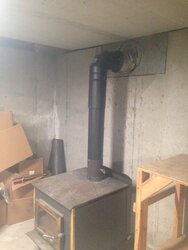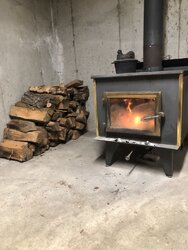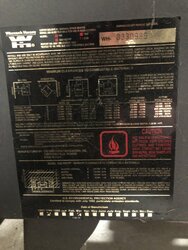Hello everybody, been to the forum before, but finally had to sign up to see if I can get some help with an issue I've recently been having. Here's the deal, I bought my home (single story ranch) last April. I grew up in a home that heats 99% by wood stove, so I've always wanted to in my home as well, it's my first house, I'm 24. When I bought the house, it had the stainless double wall insulated chimney running outside a gable end of the house, and the old Warnock Hersey stove was in the basement, no stove pipe connecting the two. So last August as the burning season approached, I cleaned the chimney, rigged up the flue, made sure all my clearances were good, etc. I burned all winter without any issues, from late October until about mid March. I wouldn't say I burned 24/7, but more like 75% of the time due to work schedules.
The only issue I would have sometimes is that I would have to crack a basement window to get the stove to draft on a cold light up, I know I have a tight house, but It hasn't really posed an posed until now. Once I got the chimney warm, no issues. This winter here in RI nights probably averaged about 18 degrees and daytime probably averaged around 25-30. Twice in the past month, from mid March until now, considerably warmer outside, 50 degree days and nights about 25-30. I have let the stove burn out and approximately 30 hours or so from the last time I load it up, my monoxide detector has sounded. It is in the basement mounted on the ceiling (CO / Smoke combo) approximately 20 feet away from my stove. My house is all electric, both heat and hot water, so nothing else in the house creates CO besides the stove. Also, I have noticed that when I open the stove door in the past month, my flames want to come outside the door and the basement gets smoked out, where throughout the winter I did not have this problem. Even when I opened the stove door for a longer amount of time to stoke it, it would still keep drafting up and out, but now it seems to want to come out of the box. Besides that, there isn't really a drafting issue on a hot fire until a day after I let the fire die out.
My theory of the CO detector sounding is that when the stove fire finally stops making enough heat to pull a draft, it loses it and finally the outdoor pressure becomes stronger and pushes what little fumes the day old fire is still throwing, back through the stove and into my house. I've checked my chimney and flue, pretty darn clean, no blockages, chimney height is adequate. Cat appears to be functioning as it should. The only change I have made is that I'm not burning as good of quality wood as I was all winter, but I'm still producing 500+ degree fires, nor do I think that would matter 30 hours later. I'm just not sure why all of a sudden I'm having this issue. All I can logically think of is the change in seasons, warmer days and cooler nights and higher pressure causing the stove to lose a draft when it is finally burning out, however I didn't have this problem when I was burning in similar conditions this past fall. I know that I have a cold chimney and a moderately tight home, but it hasn't been an issue until now when the weather is becoming warmer. My dad said he has only had his CO detectors sound twice in the past 25 years due to the wood stove, but he has a masonry chimney that's central in the home. He is an experienced HVAC Tech and seems to also believe that the combination of my cold chimney and more pressure due to the season is the culprit. If anyone has had similar issues, I could use any advice or possible solutions you had luck with. Also, If you think there's a different cause to the issue, please share!
Thank you!
The only issue I would have sometimes is that I would have to crack a basement window to get the stove to draft on a cold light up, I know I have a tight house, but It hasn't really posed an posed until now. Once I got the chimney warm, no issues. This winter here in RI nights probably averaged about 18 degrees and daytime probably averaged around 25-30. Twice in the past month, from mid March until now, considerably warmer outside, 50 degree days and nights about 25-30. I have let the stove burn out and approximately 30 hours or so from the last time I load it up, my monoxide detector has sounded. It is in the basement mounted on the ceiling (CO / Smoke combo) approximately 20 feet away from my stove. My house is all electric, both heat and hot water, so nothing else in the house creates CO besides the stove. Also, I have noticed that when I open the stove door in the past month, my flames want to come outside the door and the basement gets smoked out, where throughout the winter I did not have this problem. Even when I opened the stove door for a longer amount of time to stoke it, it would still keep drafting up and out, but now it seems to want to come out of the box. Besides that, there isn't really a drafting issue on a hot fire until a day after I let the fire die out.
My theory of the CO detector sounding is that when the stove fire finally stops making enough heat to pull a draft, it loses it and finally the outdoor pressure becomes stronger and pushes what little fumes the day old fire is still throwing, back through the stove and into my house. I've checked my chimney and flue, pretty darn clean, no blockages, chimney height is adequate. Cat appears to be functioning as it should. The only change I have made is that I'm not burning as good of quality wood as I was all winter, but I'm still producing 500+ degree fires, nor do I think that would matter 30 hours later. I'm just not sure why all of a sudden I'm having this issue. All I can logically think of is the change in seasons, warmer days and cooler nights and higher pressure causing the stove to lose a draft when it is finally burning out, however I didn't have this problem when I was burning in similar conditions this past fall. I know that I have a cold chimney and a moderately tight home, but it hasn't been an issue until now when the weather is becoming warmer. My dad said he has only had his CO detectors sound twice in the past 25 years due to the wood stove, but he has a masonry chimney that's central in the home. He is an experienced HVAC Tech and seems to also believe that the combination of my cold chimney and more pressure due to the season is the culprit. If anyone has had similar issues, I could use any advice or possible solutions you had luck with. Also, If you think there's a different cause to the issue, please share!
Thank you!
Last edited by a moderator:





